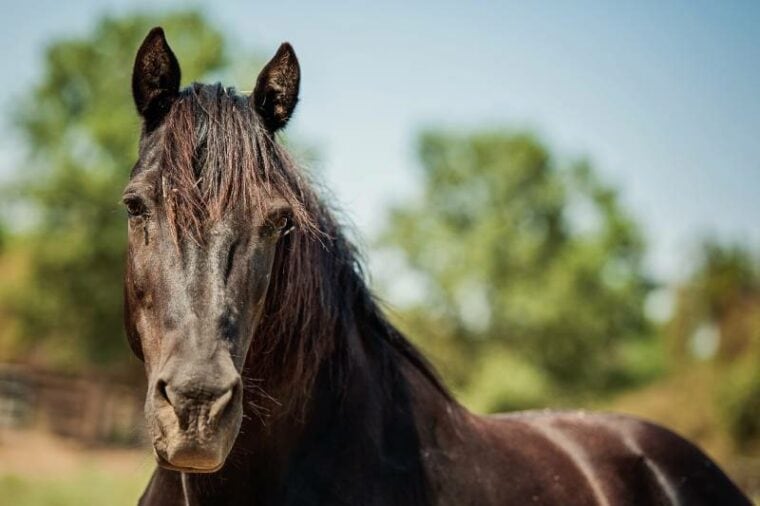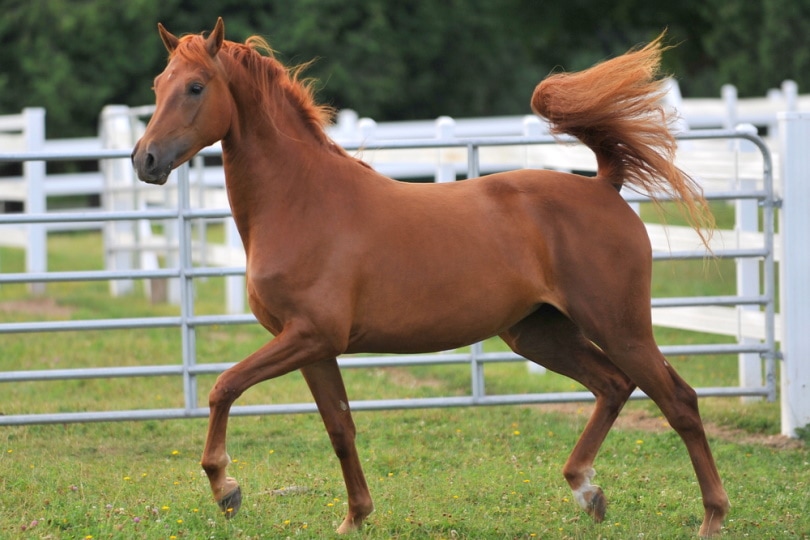
Click to Skip Ahead
Once the most popular horse breed in the United States, today the Morgan Horse is an overlooked gem. This small, hardy breed has deep American roots, but it nearly became extinct when automobiles became the standard. Despite this fall in numbers, Morgan Horses are growing in popularity again. Its adaptability and spirit make it beloved by longtime breed enthusiasts and new horse owners alike. Read on to learn if the Morgan Horse is right for you.
| Care Level: | Moderate |
| Temperature: | Adaptable—Can struggle with humid heat |
| Temperament: | Alert, energetic, spirited |
| Colors: | Any (Traditionally black, bay, chestnut) |
| Lifespan: | 20–30 years |
| Weight: | 1,000–1,100 lbs (stallion), 900–1,000 lbs (mares) |
| Height: | 14–15 hands (stallion), 12–14 hands (mare) |
The Morgan Horse is one of America’s oldest breeds—in fact, it dates back to 1789. All Morgan horses today descend from a Vermont mystery colt given to a schoolteacher named Justin Morgan. The small, beautiful stallion was a standout—it had a strength and work ethic that outstripped much larger horses.
Modern Morgan horses have the same characteristics as their ancestor—a small size, beautiful proportions, and boundless energy that keeps them working hard all day long. They’re ideal for riding, dressage, or harness work, making them a great multi-purpose choice.
Morgan Horse Breed Characteristics
What Are These Horses Used For?
Morgan horses were famous as harness horses in their heyday, pulling lightweight carriages and buggies over long distances. But they’ve always been a multi-purpose horse. Any job that requires a small but fast and hard working horse will be perfect for a Morgan—this includes pleasure riding, dressage, stock riding (herding cattle), show jumping, and endurance riding. They also make great trail horses due to their surefootedness and compact frame. They have a steady gait that makes them prized for beginner riding and therapeutic riding. This versatility is one of the reasons that Morgan Horses were once such a common breed.

Where Did These Horses Originate From?
The original ancestor of the Morgan Horse horse, a stallion owned by Justin Morgan, was well-known for its stamina in its lifetime, and it was in high demand as a stud. The breed as we know it today was developed from three of the original stallion’s sons. It quickly became a dominant breed throughout the 19th century. In fact, at one point it was the most popular breed in America! But in the 20th century, the breed fell in popularity as harness horses became less common and demand shifted to larger horse breeds. In the past few decades, interest in the breed has risen again, and the Morgan horse population is on the rise.
Temperament & Intelligence of the Morgan Horse
Morgan Horses are known for their adaptability and good temper. They are alert, vigorous horses that rarely have issues with behavior. If you own a Morgan Horse, you will be able to ride or work with it for long hours without any sign of tiredness or complaint. Most Morgan Horses have a business-like attitude, but some can have a sassy or spunky streak as well. Overall, their temperament makes them great for owners of all experience levels.
On the other hand, Morgan Horses also have a tendency to become bored or frustrated if they aren’t properly stimulated. This is a breed that is used to working hard, and if you aren’t putting it to work every day, it might become frustrated.
Some Morgan Horses also spook easily. Unexpected birds, snakes, or blowing trash can cause this breed to become scared. However, an experienced owner can calm a frightened horse without too much trouble.
Appearance & Varieties
The Morgan Horse is a short, compact horse with smooth lines, expressive eyes, and a graceful gait. These beautiful horses are small to medium in size, averaging around 1000 lbs. They can come in any color or pattern, but blacks, bays, and chestnuts are the most common.
There are several different varieties of Morgan Horse available. The most traditional family is the Lippitt Morgan. These horses were bred to most closely resemble the original horse owned by John Morgan. Brunk Morgan horses are descended from a breeding program that favored athletic horses. Foundation Morgan horses are bred to be stockier and stronger than the traditional Morgan type. In 1990, the Rainbow Morgan Horse Association was founded to promote the breeding of unique and rare colors in the breed.

Things to Know When Owning a Morgan Horse:
Habitat & Stable Requirements 🌾
The Morgan Horse is one of the most adaptable horses out there, bred for use all over the United States. They can endure cold temperatures and warm temperatures equally well, but they do sometimes struggle with hot, humid weather. You should provide your horse with adequate shelter to protect them from wind, rain, and snow.
Morgan Horses are happiest when they have access to a good-sized pasture for running and walking. A good rule of thumb is that you should have one acre of land per horse plus one additional acre—so one horse should have at least two acres of pasture, while four horses can live on a five-acre pasture.
If your horse is kept in an indoor stable, you should make sure it has proper stall space. A horse’s stall should have enough room to turn around, lie down, and roll over. The more time your horse spends indoors, the larger its stall should be.
Food & Diet Requirements 🥕
One advantage to owning a Morgan Horse is that their smaller size comes with a smaller appetite. In general, horses need 1.5–2% of their body weight in hay each day. In Morgan Horses, that generally translates to 15–20 pounds of hay. Smaller, older, and less active Morgans will need a little less food, while larger, younger, and more active Morgans will eat more. If your horse has pasture available, they can get some or all of their food needs from forage, especially in the spring and summer.
Along with hay, horses need access to clean water at all times. Horses can drink several gallons of water each day, so it’s important to keep your horse’s water trough full and clean. Your horse should also have a salt lick available to eat. Grain is usually optional for Morgans, but if your horse is nursing a foal or being used for rigorous work, you’ll want to make sure to add it into your horse’s diet.
Exercise 🐎
Morgan Horses need plenty of room and time to exercise every day. Access to a large pasture or corral will give your Morgan Horse space to move and exercise. Most Morgan Horses are happiest if they are able to work with their owners every day. Morgan Horses are able to withstand hours of exercise each day without complaint.

Training 🐴
The Morgan Horse is a very trainable breed. They can learn to do almost any type of riding or work. You should use gentle methods and positive reinforcement to break or train a Morgan Horse. Start with halter breaking—you can halter break a foal at any time after one week of age. From there, you should wait to saddle or harness break your horse until it is between two and three years old. If you plan to use your Morgan horse in jumping, dressage, racing, or other more specialized sports, you can start that training once your horse is thoroughly broken and accustomed to the saddle or harness.
Like all horses, Morgan Horses don’t respond well to harsh punishment, forceful methods, and anger when it comes to training. Instead, work to build your horse’s trust so that you have a strong, healthy working relationship.
Grooming 🧽
You should groom your horse regularly to make sure that its coat, mane, tail, and hooves are healthy and clean. Most Morgan horses need light grooming once a week. In the spring and fall, you may want to groom more often as your horse sheds its winter and summer coats. It’s especially important to make sure that your horse’s hooves are kept clean and free from debris—a stone lodged in a horse’s hoof can cause injury and lameness.
Lifespan & Health Conditions 🏥
The Morgan Horse is a relatively healthy breed, but it does have its issues. Morgan horses are an active, high-metabolism breed, but this can make them prone to eating too much, especially if they aren’t kept active. This can lead to excess weight gain and related complications.
Morgan horses also have a higher than normal chance of inheriting polysaccharide storage myopathy or PSSM, a rare muscle disorder. This can cause muscle stiffness, lameness, and gait changes in horses.
Male vs Female
Male and female horses have their own pros and cons. Males are generally larger and stronger than mares, whether or not they are gelded. In general, stallions (unaltered males) are more aggressive and spirited than either geldings (altered males) or males. Stallions often have to be kept away from other horses, as they can become territorial. They also will often try to mate with mares, so they should be kept apart unless you want to breed. Both geldings and mares generally get along well with other horses and have a more docile, easy going temperament than stallions.
3 Little-Known Facts About the Morgan Horse
1. They were Civil War stars
At the time of the Civil War, Morgan Horses were arguably the most popular breed in the US. This meant they were often used by Cavalry on both sides of the war.
2. They Ran the Pony Express
Pony Express riders used many different breeds, but Morgan Horses were among the most prized for their speed and reliability.
3. Cars Nearly Killed Them
Since Morgan Horses were used in harness (pulling carriages or carts) more than in saddles, the rise of the automobile was worse for them than many breeds. The breed was nearly extinct by the mid-1900s, but today it’s making a comeback!

Final Thoughts
Because this breed is so adaptable and versatile, they’re a great choice for horse owners of all experience levels. They are social and can be trained to get along well with other pets and livestock such as dogs and cattle. They do get bored easily if they aren’t worked with regularly, so it’s important to consider how much time you’ll be able to ride your horse. Overall, if you want a smaller but hardy horse breed that will win your heart with its sweet temperament, the Morgan Horse might be right for you.
Featured Image Credit: Horse Crazy, Shutterstock








